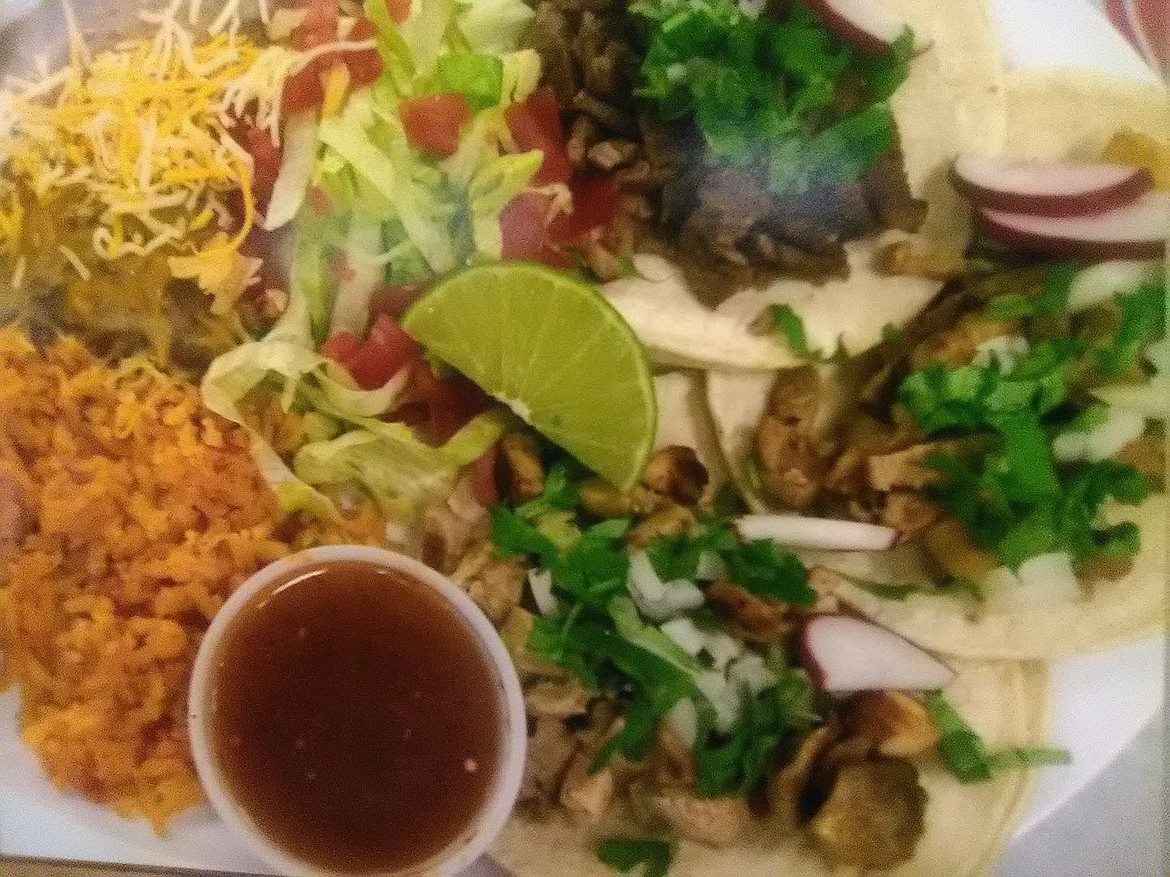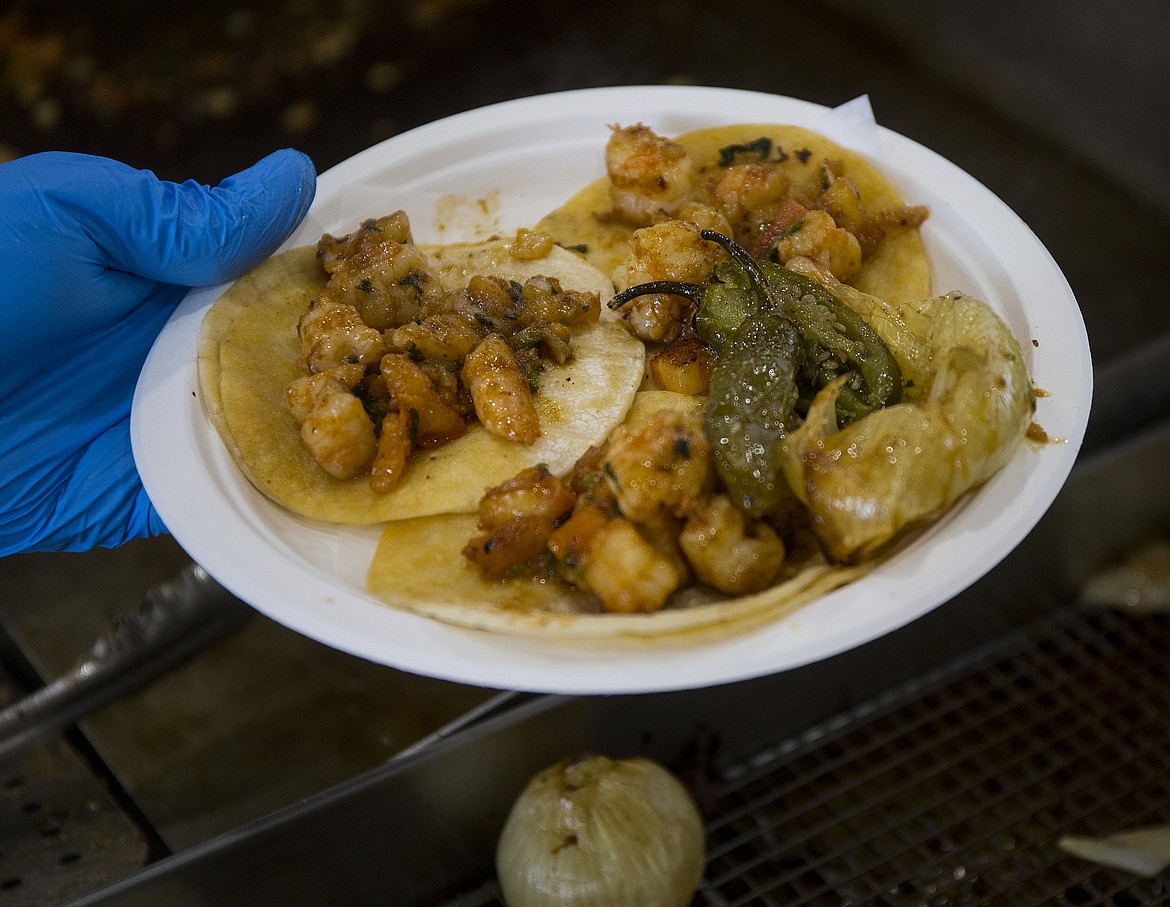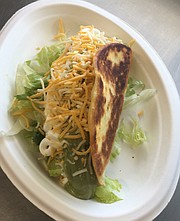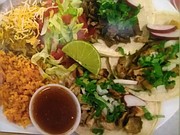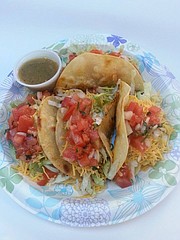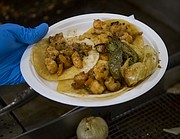Tacos everywhere
Rosemary Anderson Coeur Voice Writer | Hagadone News Network | UPDATED 7 years, 7 months AGO
Whether they come from a truck, a trailer, a restaurant or a kitchen, tacos are a delicious tradition that’s become a staple of the American food service industry.
The people in the U.S. who make them and the places they come from are as diverse as the tacos themselves. Some tacos are traditional to Mexico, while others contain wacky ingredients like spaghetti or marshmallows. Some tacos are handheld and can be eaten in a few bites, while others require a fork and handful of napkins.
In Coeur d’Alene, taco consumers have a lot of options. With at least 20 different Mexican restaurants in the area and today’s Cinco de Mayo celebrations, a bigger pair of pants may be necessary.
As locals line up for or sit down to a plate of tacos, Mary Hayes, owner of Nina Mary’s taco truck on Fourth Street, hopes new customers will recognize the history and hard work of taco artistry.
In the beginning
Although the taco came to Mexico before the Spanish language, the origins of the taco are foggy.
According to some history books, tacos were invented in the 18th century by silver miners who wrapped their meals up in tortillas - like they wrapped dynamite in paper. Some believe the wives of Mexican field workers invented the taco, while others are certain native Aztec people ate them first.
“How the taco started, who knows,” said Omar Magdalena, owner of Taco Works in the Best Avenue food court. “It has been around since the beginning, and every part of Mexico has their own story.”
Jeffrey M. Pilcher, a University of Minnesota professor and expert on Mexican food history, told Smithsonian.com in a 2012 interview that the first mention he has seen of tacos in the U.S. was in a 1905 newspaper article, at a time when Mexican immigrants were beginning to arrive, working the mines and railroads.
Mexican food was considered street food, Pilcher said, associated with a group of women called the Chili Queens, street vendors in San Antonio who sold food during festivals.
“When tourists started arriving in the 1880s with the railroad, these occasional sales started to become a nightly event,” Pilcher said. “Tourists came looking for two things in San Antonio—the Alamo and the Chili Queens.”
‘Anything wrapped in a tortilla’
Traditional tacos were made with maize, corn, or flour shells and were made al pastor or adobada, translating to shepherd style, which contained rotisserie style steak and adobo, a paprika seasoning mixture. Carne asada, grilled beef, and lengua, beef tongue, were also popular taco fillings.
“To a Mexican, a taco is just anything wrapped in a tortilla,” Hayes said. “You could wrap your leftover beans and potatoes from the fields or a slice of bologna in a tortilla, and it would still be a taco.”
At Hayes’ taco truck, a bologna taco is not on the menu. As well as the traditional fillings, she serves pollo (chicken), pescado (fish), picadillo (shredded beef), carnitas (braised pork), ground beef and shrimp.
The “street taco,” which is typically classified as a soft corn tortilla filled with veggies and carne asada, marinated steak, is Hayes’ specialty.
Hayes learned to cook at the age of 4. Her grandmother let her stand on a chair to stir ingredients, potholder in one hand and spoon in the other. She describes her style of cooking as “Cali-Mex,” inspired by her American roots.
“All my Mexican family in town makes good food, but we all cook different,” she said. “We can cook traditionally, but we will make different things if people want something different.”
Opening in 2010, Nina Mary’s taco truck was supposed to be a restaurant, but Hayes did not have the funds. Even today, Hayes does not cook to get rich, but to spread her passion for Mexican food with the Coeur d’Alene area.
“I take pride to see good quality of food come out of my window,” she said. “That’s why I am the only employee here. When I went on vacation in the past, my customers noticed it wasn’t my food. Now, I close shop when I leave because my customers say, ‘We’ll wait for you.’”
The victim of burglaries and targeted racial crimes, Hayes said she is not disappointed. Located across the street from Pilgrim’s Market, she said even her vegetarian and health-conscious customers are loyal.
“I grew up eating all that fat food from Mexico, fried in lard and grease,” she said. “So, I don’t use lard, and I drain all my meats thoroughly.”
The only thing Hayes won’t do is cook hard shell tacos.
Hard-shell tacos and more trucks
Not traditional to Mexico, the hard corn shell began in American in the early 1900s as a tool for fast food production. Because the shells could be mass produced and its hard U-shape made it easy to hold and be filled, the hard taco shell became popular in the American food industry.
“A lot of people think a ‘taco’ is a hard-shell taco and a ‘street taco’ is a soft-shell taco,” she said. “Those terms were started by Americans, a ‘street taco’ is just a normal taco to Mexicans.”
To find hard-shell tacos in Coeur d’Alene, one of the area’s four Taco Works trucks would be a good place to start.
The first taco truck entrepreneur in Coeur d’Alene, owner Omar Magdalena came to America to work for Idaho’s forest service, cutting and planting trees and building trails. In 2003, Magdalena bought a taco cart and pushed it around Appleway Avenue every morning, whether it was sunny, rainy or snowy.
After a few years Magdalena got tired of the wind and wanted a permanent shop. With help from a kind real-estate agent, Magdalena now owns and operates the biggest food truck chain in town. In addition, he inspired the taco truck food court on the intersection of Best Avenue and Fourth Street.
“After 15 years, I still love making tacos,” Magdalena said. “No matter how busy I get, I don’t get stressed because this is my passion.”
On Tuesdays - the weekday traditionally reserved for taco discounts throughout the Mexican food industry - Taco Works builds huge lines, so Magdalena has hired a few extra employees beside his family members. Although Taco Tuesday was started in 1982 by Taco John’s, Magdalena said the fun tradition existed in Mexico, and he has been excited to see it become so popular in Coeur d’Alene.
Another popular food truck, Tacos Los Panchos, owned by Mario Ibarra, a self-identified “chef-ninja-extraordinaire,” does not participate in Taco Tuesday because it is too expensive for his business.
One of the smaller taco trucks in the area, Ibarra still boasts a full menu with unique ingredients like barbacoa, slow-cooked beef, and potatoes.
Although Ibarra started the food truck with his son, he said now the kids will only help when they want to eat. Starting a taco truck had been a dream of his for 25 years, and he has been happy to find a loyal customer following. “Even on a snowy day, the regulars still make their daily pilgrimage to the taco-Mecca of North Idaho,” said Ibarra. “Our menu isn’t something you will find at your local fast food joint--the taste is fresh and its way healthier than a grease-covered tortilla made from mostly high fructose corn syrup.”
He warns customers that after the first bite, they will always come back.
Restaurant tacos, too
If the taco truck picnic benches get full, Mexican restaurants are always an option.
Toro Viejo, translating to Old Bull, has been the longest running Mexican restaurant in downtown Coeur d’Alene. Opened in 1997 by Ruben Briseno, it serves large taco meals that leave its customers satisfied.
“We are always busy, especially with Taco Tuesday,” he said. “We have been busy for 26 years now this December.”
The restaurant on Second Street is also a popular caterer for local events and parties.
The other “viejo” restaurant in the area, Rancho Viejo, translating to Old Ranch, is located in Post Falls, Hayden Lake, Spokane, Spokane Valley and Pullman.
Owner Jose Rodriguez learned how to cook from his mother and grandmother, gaining the confidence to open his first restaurant in 1980. Now, his Mexican restaurant chain is one of the most popular restaurants in the Northwest.
“My customers would always ask me when I would open new restaurants, so their friends in other towns could try,” Rodriguez said. “Eventually I gave in, and now I have over five restaurants.”
Realizing the gaining popularity of tacos, Rodriguez opened his first taqueria, El Taco Loco, on Canfield Avenue. His taco fillings include - along with more familiar beef, beef and shrimp offerings - tripa (beef belly), lengua (beef tongue) and buche (pork belly).
“There are tacos everywhere,” he said. “I’ve been excited to join the trend.”
As the taco industry continues to expand, the local Mexican food truck and restaurant owners hope Coeur d’Alene continues to appreciate traditional Mexican foods and remain just as passionate about tacos as they are.
ARTICLES BY ROSEMARY ANDERSON COEUR VOICE WRITER

A part of art
Beads of sweat acted like glue, sticking shirts to skin. People patted their foreheads with napkins while admiring a variety of art at the White House Event Center on Sherman Avenue in Coeur d’Alene.

No headline
Almost every vintage car driving on Coeur d’Alene streets has been touched by Tim Hein.

Making their mark
The smell of acrylic paint drifts, on Tuesday and Thursday nights, from the end of Coeur d’Alene’s Walnut Avenue. Here, a group of young artists are putting their paint brushes together to add color and character to a local nonprofit.



